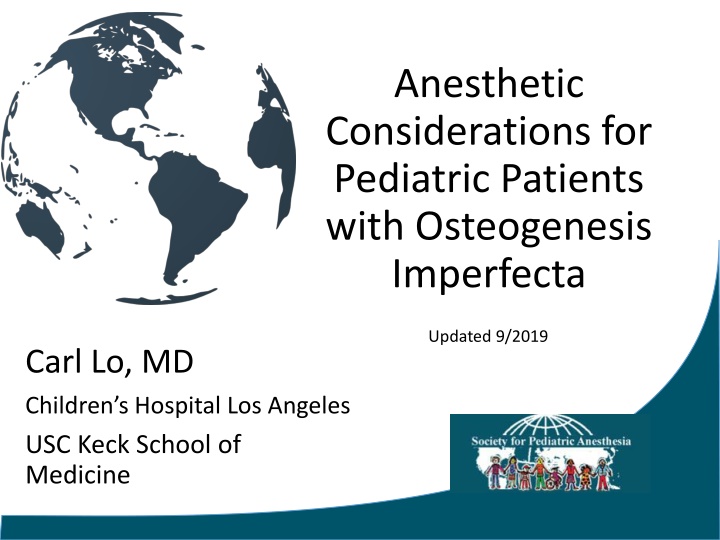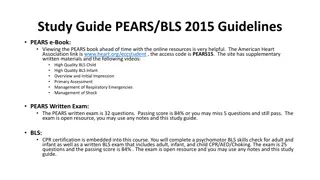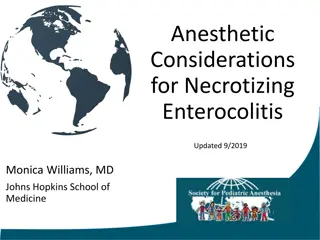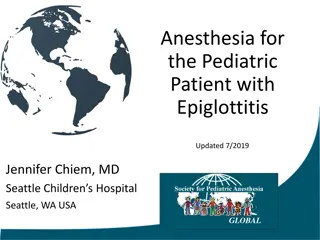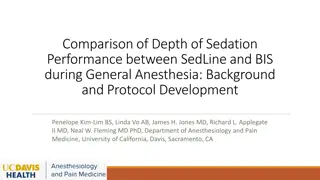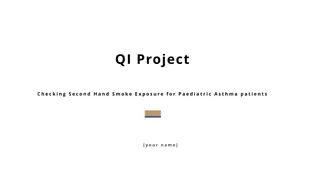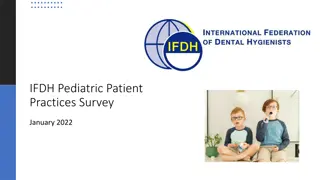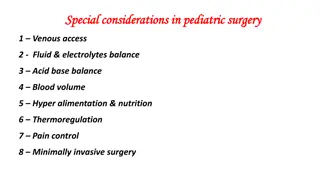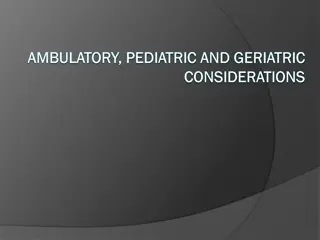Anesthetic Considerations for Pediatric Patients with Osteogenesis Imperfecta
This presentation discusses the pathophysiology, clinical features, diagnosis, and common surgeries for pediatric patients with Osteogenesis Imperfecta (OI), a genetic disorder affecting bone integrity. It emphasizes the importance of preoperative considerations, formulating appropriate anesthetic plans, and preventing further fractures in OI patients peri-operatively.
Download Presentation

Please find below an Image/Link to download the presentation.
The content on the website is provided AS IS for your information and personal use only. It may not be sold, licensed, or shared on other websites without obtaining consent from the author.If you encounter any issues during the download, it is possible that the publisher has removed the file from their server.
You are allowed to download the files provided on this website for personal or commercial use, subject to the condition that they are used lawfully. All files are the property of their respective owners.
The content on the website is provided AS IS for your information and personal use only. It may not be sold, licensed, or shared on other websites without obtaining consent from the author.
E N D
Presentation Transcript
Anesthetic Considerations for Pediatric Patients with Osteogenesis Imperfecta Updated 9/2019 Carl Lo, MD Children s Hospital Los Angeles USC Keck School of Medicine
Disclosures No relevant financial relationships
Learning Objectives: Describe preoperative considerations in managing pediatric patients with Osteogenesis Imperfecta (OI) Formulate an appropriate anesthetic plan for patients with OI Avoid any further fractures in OI patients peri-operatively
Pathophysiology Brittle bone disease Estimated at 1 in 13,500 Genetic disorder of connective tissue Most OI has mutation in genes that code for collagen type I alpha chains, COL1A1 and COL1A2 Collagen is the main component of organic bone matrix and a key ingredient in bone tissue integrity
Pathophysiology Abnormal collagen synthesis leads to bone fragility and other skeletal deformities Multiple subtypes - Type I-most common, mildest - Type II-most severe/lethal - Type III-severe, but survivable - Type IV-severity between type I and III - Many other subtypes with similar clinical presentation as above
Clinical Features Bone fragility Blue or grey discoloration of the sclera Dental discoloration, tooth fracture, and attrition Dysplasia of the mandible and maxilla Decreased muscle mass Rarely associated with posterior fossa compression, Chiari malformation, spinal cord syrinx formation and hydrocephalus
Diagnosis Molecular tests analyze structure and quantity of type I collagen synthesis Definite diagnosis is by clinical traits
Common Surgeries Performed Orthopedic surgeries for fracture repair Intramedullary rod implant to improve function and ambulation Deformity corrections Telescopic rods for vertical height gain
Preoperative Evaluation Airway evaluation: assess OI severity Excessive neck extension may lead to atlantoaxial subluxation and dislocation Reasons for potentially difficult airway Brittle bones C-spine instability Short neck Edentulous
Preoperative Evaluation Airway techniques - Direct laryngoscopy: avoid in patients with C-spine instability and consider videolaryngoscope or fiberoptic bronchoscope for intubation - Mask: avoid excessive force - LMA: least invasive way to ventilate, and a great rescue airway device Avoid further fractures!
Preoperative Evaluation Pulmonary Evaluation - Restrictive lung disease - Kyphoscoliosis - Pulmonary hypertension - Cor pulmonale Cardiac Evaluation - Premature atherosclerosis - Valvular disease
Preoperative Evaluation Hematologic Evaluation Poor collagen function on platelet- endothelial cell may lead to bleeding diathesis Platelet dysfunction from capillary fragility (qualitative, not quantitative) Coagulation test to rule out platelet dysfunction for surgery and regional anesthesia
Intraoperative Implications Anything can cause iatrogenic fractures! PIV placement Tourniquets placement Blood pressure cuff Surgical position Transport Careful padding needed
Intraoperative Implications Succinylcholine Hyperkalemic arrhythmia in immobile patients Succinylcholine induced fasciculations can cause fractures! Twitch monitor can cause fractures!
Intraoperative Implications Hypermetabolic state Can be triggered by atropine/glycopyrrolate Symptoms: excessive diaphoresis, hyperthermia, tachycardia, and tachypnea Avoid routine use of warming devices without monitoring temperature This hyperpyrexia reaction not associated with MH (malignant hyperthermia)
Brittle Bone Myths Recent study in the Journal of Pediatric Orthopedics 37 OI patients underwent 96 orthopedic procedures NIBP cuffs used in 81 surgeries Tourniquets applied to lower extremity at a pneumatic pressure of 250 mm Hg in all patients No iatrogenic fractures with NIBP cuff use No fractures associated with tourniquet use One patient had a humerus fracture from preoperative patient positioning
Regional Anesthesia Preferred method in OI patients with severe cardiac/pulmonary diseases Peripheral regional anesthesia - Nerve stimulator at high voltage at cause fractures! - Ultrasound guidance is preferred Neuroaxial anesthesia - Platelet dysfunction in OI patients can result in epidural hematoma
Postoperative Disposition Postoperative sedation to avoid further fractures Hemorrhagic diathesis from platelet dysfunction If the patient has restrictive lung disease may need PICU admission postoperatively
Conclusions: Identify severity of OI Preoperative evaluation - Airway - Cardiopulmonary - Hemotologic Fracture, fracture, fracture! Avoid succinylcholine Consider regional anesthetic options Postoperative disposition
References: 1. Van Dijk FS, Cobben JM, Kariminejad A, et al. Osteogenesis Imperfecta: A Review with Clinical Examples. Mol Syndromol. 2011;2(1):1-20. 2. Basel D, Steiner RD: Osteogenesis imperfecta: recent findings shed new light on this once well understood condition. Genet Med 2009; 11: 375 85. 3. Santos ML, Anez C, Fuentes A, et al. Airway management with ProSeal LMA in a patient with osteogenesis imperfecta. Anesth Analg 2006; 103: 794. 4. Carlson Jay, Halrass F. Management of Osteogenesis Imperfecta in Pregnancy. Journal of Reproductive Medicine, 1993; 38.
